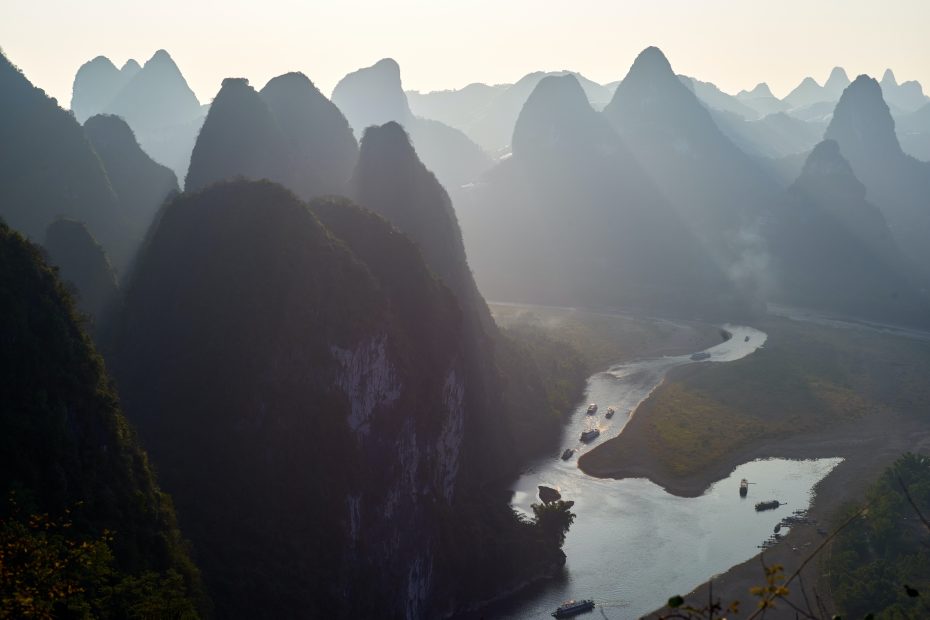Introduction
Nestled among the karst mountains of China’s Guangxi region, Guilin has long enchanted visitors with its breathtaking landscape. Known for its majestic limestone peaks, meandering rivers, and lush greenery, this city has an almost mythical beauty that has inspired poets and painters for centuries. Let’s explore why Guilin continues to be one of China’s top scenic destinations.
Scenic Attractions
The Li River is undoubtedly Guilin’s crown jewel attraction. Its tranquil jade waters, flanked by soaring karst peaks, offer a relaxing cruise that showcases the region’s splendid scenery. Reed Flute Cave dazzles with its vast chambers adorned with stalactites and stalagmites. Lit by colored lights, this natural wonderland revealsnature’s subterranean splendor.
For city views, head to Seven Star Park. Named after seven peaks resembling the Big Dipper, this park offers panoramic vistas of Guilin. Nearby is Elephant Trunk Hill, whose shape resembles an elephant drinking water with its trunk. It’s an iconic Guilin landmark.
Just outside the city, the Longsheng Rice Terraces present a patchwork of water-filled paddies cascading down hillsides. It’s a sight of agricultural ingenuity blended seamlessly with nature.
Cultural Significance
With a history stretching back over 2,000 years, Guilin has long held cultural importance. It was a critical juncture on the ancient Southern Silk Road and served as an administrative center for northern Guangxi.
Today, Guilin is home to multiple minority groups, like the Zhuang and Yao people, who contribute unique traditions. Experiencing their customs offers deeper insight into the region.
Guilin cuisine also stands out for its use of local produce and signature dishes like Guilin rice noodles. Sampling the food is an integral part of understanding the city’s cultural essence.
Activities
Given Guilin’s natural splendor, outdoor activities abound. Hiking the countryside trails and bamboo forests allows you to soak in the idyllic landscapes. River cruising provides a relaxed perspective from the water. Cycling is a great way to explore at your own pace. For adventure, try rock climbing on the karst cliffs.
Accommodation
Guilin offers varied accommodation, from luxurious hotels to quaint hostels and local homestays. Hotels range from international chains in the city center to scenic resorts on the outskirts. Budget hostels provide affordable dorms or private rooms. Homestays immerse you in local life with homecooked meals and insights from your host.
Getting Around
Guilin can be explored on foot, by bike, bus, taxi, rideshare apps or tourism shuttles. Consider river cruises between attractions like Reed Flute Cave and Seven Star Park. Buses and tours enable trips to the Longsheng Rice Terraces. Taxis are readily available, affordable and can be booked through apps.
Best Time to Visit
Spring (March-May) and fall (September-November) have mild weather ideal for outdoor exploration. March-April offer pleasant temperatures and blooming countryside flowers. September-October host the International Tourism Expo. Summer is hot and humid with more rain, but lush greenery. Winter is cool but dry and peak season.
Conclusion
With breathtaking natural beauty, fascinating culture and endless activities, Guilin offers an unforgettable travel experience. Its karst mountain vistas have inspired admiration for generations. Whether cruising the Li River or hiking rice terraces, Guilin promises to captivate your imagination and provide a scenic sojourn to cherish. Don’t miss exploring this enthralling Chinese destination.
FAQs
What is Guilin known for?
Guilin is famous for its iconic karst limestone formations that create a dramatic and picturesque landscape of lush peaks flanking clear rivers.
When is the best time to visit Guilin?
The best times are spring (March-May) and fall (September-November) when the temperatures are comfortable. March-April offer pleasant weather with blooming flowers while September-October have the Tourism Expo.
What is there to do in Guilin?
Top activities include cruising down the Li River, exploring caves like Reed Flute Cave, hiking in the karst mountains, cycling through rice paddies, visiting cultural sites and ethnic villages, rock climbing and enjoying the local cuisine.
How many days do you need in Guilin?
At least 3 full days are recommended to see the top sights at a relaxed pace. With 5-7 days you can take in more attractions in and around the city as well as the Longsheng Rice Terraces.
What is the food like in Guilin?
Guilin is known for its fresh regional produce like bamboo and Osmanthus flowers. Signature dishes include Guilin rice noodles, steamboat hotpot, Guilin sanhua jiu (wine), and dongpo rou (braised pork belly).
